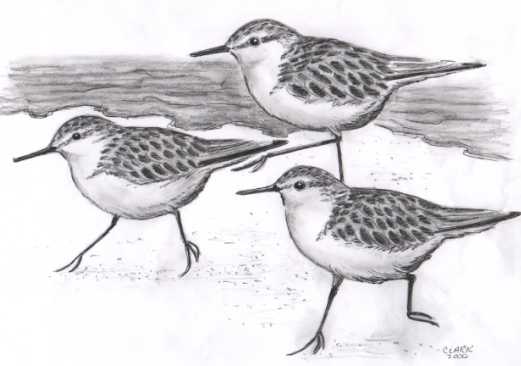
Dear Bird Folks:
I have some friends from Pittsburgh coming to visit who would like to do some bird watching. They are coming to Cape Cod to see sandpipers. Unfortunately, except for the birds in my backyard, I really don’t know much about bird watching. Do you have any suggestions fo where I might tell my friends to find sandpipers?
– Julie, W. Dennis
Come on Julie,
Do you really need me to tell you where to find sandpipers? Just think about it for a second. If you were a sandpiper, what part of Cape Cod would be your favorite place to go? The deep woods? An overgrown field? Your neighbor’s suet feeder? Or how about the beach? I know that all this sounds a bit sarcastic, which is so unlike me, but this really is a no brainer. Any beach this time of year should produce some sandpipers and a few special beaches could produce thousands.
With few exceptions, sandpipers, aka shorebirds, like their name implies, spend most of their lives near water, particularly saltwater. And lucky for them, and us, Cape Cod has plenty of saltwater. Most shorebirds breed way up in the tundra region of northern Canada. They need our crowded little peninsula as a resting and refueling stop for their long journey south. The problem is that shorebird migration occurs during the peak summer months, when our beaches are the most crowded. These little 2-ounce birds are forced to compete with kids, with kites, women in big hats, men in Speedos, and dogs that are mostly naked. Even though all beaches attract some birds, the beaches that attract the most birds are the ones with the fewest people and the fewest naked dogs.
The beach that shines above all others in this regard is South Beach in Chatham. A relatively new birding oasis, South Beach, was created in 1987, when a nasty winter storm ripped North Beach in half. At first, South Beach was an island and for the first time in decades, the ubiquitous SUVs were prevented from their seasonal invasion. Recently, South Beach has once again connected to land, but fortunately for the birds, the cars have been asked to remain on the mainland.
In 16 short years, South Beach has become one of the premier birding spots in the Northeast. Over 40 different species of sandpipers have been seen there, with many of the species rarely seen anywhere else. And we are not talking about a few birds here. Flocks of several thousand shorebirds are often seen at high tide, making a spectacle that few people, especially from Pittsburgh, have witnessed. In addition to the shorebirds, hugh flocks of terns, other seabirds and rare birds of prey can be seen on South Beach in late summer into early fall.
Although South Beach is walkable (a very, very long walk from Chatham Light), the best way to go, unless you enjoy sweating or are looking to lose weight, is by boat. Mass Audubon in Wellfleet and the Cape Cod Museum of Natural History in Brewster both run trips to South Beach. A small fee gets you a quick boat ride over, a trained naturalist and a state-of-the-art sunburn. You should also keep in mind that the small fee is an important source of revenue for these two wonderful and very important environmental organizations, so don’t whine about it. Several private businesses will also ferry birders over to South Beach, but since none of them have ever offered me a free trip, they aren’t about to get a plug from me.
If your company is less ambitious, there are plenty of alternatives. The Mass Audubon property in Wellfleet contains several tide pools that are easy to walk to and that are often full of shorebirds. Even crowded beaches will have birds late in the day when the beachgoers have moved out. Your friends can look for birds then while everyone else is off enjoying the perfect Cape Cod evening which, or course, is waiting in line for mini golf, ice cream and a $15 clam roll.